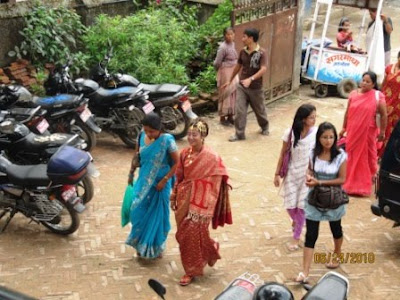










The past two days we have been attending the wedding of two of Claire’s new cousins, two brothers, Sujan and Suman, and their respective new wives, Liza and Marena. For those who know Dilli Padu who came to the U.S. for the wedding in December, they are two of his nephews.
On Thursday we dressed up and left at 9:00 a.m. to go to a temple just outside of town. Several different weddings were going on at once in the temple area, most of them Hindu, and it was explained to me that the Newari Buddhist customs are somewhat different from the Hindu ones. We were at the temple all day until the evening. First all the guests arrived and were fed tea, hard-boiled eggs, and sweet breads. We chatted, watched the other weddings, met more relatives, and after awhile the two brides arrived, dressed in the bridal color, which here is red.
There were first some rituals inside the small inner part of the temple with just the couples, priest, and parents, and whoever else could crowd in. Then there were other rituals outside with everyone watching. Unlike Western weddings, in which everyone stays quietly in their seat, here everyone was crowded around, coaching the couples, telling them what to do next, handing them necklaces, rings, etc., to give toeach other, helping them, and so on. There were not that many words, it was mostly actions.
We were told that the customs in the two brides’ families are somewhat different, so different adjustments were made to accommodate the three family traditions involved. There was one part later in which all the family members lined up and gave the brides money and were given nuts and candies in return. There were other parts that involved the giving of different gifts of food and clothing. When it was lunchtime, lunch was served, and when it was dinner time, dinner was served.
After everything was finished at the temple some of the family members (including us) rode in a van to the grooms’ parents’ home, where the two couples will live. After much preparation, a ritual was conducted there in which the new mother-in-law, Pushba, came out dressed in a bridal sari herself and, after several blessing, held out a key, which one of the daughters-in-law grasped, by which she was pulled into the house. Since there were two of them, the second daughter-in-law grabbed the first one’s sari and came behind here. As one of the cousins put it, “They got their ticket, they got their visa, and this is the entrance permit.”
Yesterday evening we dressed up even more in saris (with a lot of help from Dilli Mama, Erika, and Auntie Sunila, who had just arrived from Italy) and walked through the neighborhood to the wedding feast. Thirteen hundred people were there. It was outdoors, there was a live band, an open bar, and dinner. The brides sat in a small alcove and received guests and gifts all evening, but the grooms roamed around greeting the guests. All of the “aunties” wore new identical red saris given to them by the grooms’ parents.
Between the two events we met a great many of Claire’s new family members, many of whom will travel to Pokhara next week for her and Sajal’s wedding. It will be very interesting to see how it is similar and how it is different. Since both Sajal’s parents and we had made so many modifications in the way we do weddings to fit it to their international and interreligious situation and the differences in customs, Claire was very relieved to hear that even among Nepalis families must make adjustments to account for differences in families.
All of Sajal’s family have been very warm and welcoming to us. Getting to know them has been very reassuring as I consider my daughter living here with them. This evening the first of the other guests from the U.S. arrive, Teri Lloyd, Erin and her husband Chris, and Colin, and tomorrow morning Don and Ian and Leyla arrive. Wednesday we will travel to Pokhara.









































